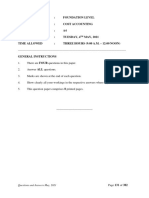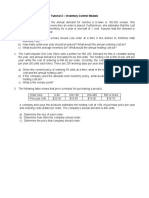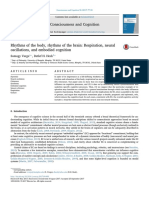0 ratings0% found this document useful (0 votes)
383 viewsAssignment - Working Capital Management
Thompson Paint Company uses 60,000 gallons of pigment per year. The cost of ordering is $200 and carrying inventory costs $1 per gallon annually. The firm needs to calculate the economic order quantity and reorder point.
Regency Rug Repair is considering relaxing credit standards. Currently, collection period is 40 days, bad debts are 1% of sales, and variable costs are $28 per unit. If standards are relaxed, collection may rise to 48 days and bad debts to 1.5% of sales, while sales rise 4,000 units. The firm needs 14% returns and justification is required.
Hurkin Manufacturing pays accounts payable in 10 days, collects in 30, and ages
Uploaded by
AlmasCopyright
© © All Rights Reserved
Available Formats
Download as DOCX, PDF, TXT or read online on Scribd
0 ratings0% found this document useful (0 votes)
383 viewsAssignment - Working Capital Management
Thompson Paint Company uses 60,000 gallons of pigment per year. The cost of ordering is $200 and carrying inventory costs $1 per gallon annually. The firm needs to calculate the economic order quantity and reorder point.
Regency Rug Repair is considering relaxing credit standards. Currently, collection period is 40 days, bad debts are 1% of sales, and variable costs are $28 per unit. If standards are relaxed, collection may rise to 48 days and bad debts to 1.5% of sales, while sales rise 4,000 units. The firm needs 14% returns and justification is required.
Hurkin Manufacturing pays accounts payable in 10 days, collects in 30, and ages
Uploaded by
AlmasCopyright
© © All Rights Reserved
Available Formats
Download as DOCX, PDF, TXT or read online on Scribd
You are on page 1/ 1
Working Capital Management
Assignment
Book: (1) Principles of Managerial Finance by Gitman.
(2) Fundamentals of corporate finance by Brealy, Myres, and Marcus.
Q#01: EOQ analysis
Thompson Paint Company uses 60,000 gallons of pigment per year. The cost of ordering pigment is $200
per order, and the cost of carrying the pigment in inventory is $1 per gallon per year. The firm uses
pigment at a constant rate every day throughout the year.
a. Calculate the EOQ.
b. Assuming that it takes 20 days to receive an order once it has been placed, determine the reorder point
in terms of gallons of pigment. (Note: Use a 365-day year.)
Q#02: Relaxing credit standards
Regency Rug Repair Company is trying to decide whether it should relax its credit standards. The firm
repairs 72,000 rugs per year at an average price of $32 each. Bad-debt expenses are 1% of sales, the average
collection period is 40 days, and the variable cost per unit is $28. Regency expects that if it does relax its
credit standards, the average collection period will increase to 48 days and that bad debts will increase to
11/2% of sales. Sales will increase by 4,000 repairs per year. If the firm has a required rate of return on
equal-risk investments of 14%, what recommendation would you give the firm? Use your analysis to justify
your answer. (Note: Use a 365-day year.)
Q#03: Cash conversion cycle
Hurkin Manufacturing Company pays accounts payable on the tenth day after purchase. The average
collection period is 30 days, and the average age of inventory is 40 days. The firm currently has annual
sales of about $18 million and purchases of $14 million. The firm is considering a plan that would stretch
its accounts payable by 20 days. If the firm pays 12% per year for its resource investment, what annual
savings can it realize by this plan? Assume a 360-day year.
Q#04: Credit Decision/Repeat Sales.
Locust Software sells computer training packages to its business customers at a price of $100 in present
value terms. The cost of production (in present value terms) is $95. Locust sells its packages on terms of
net 30 and estimates that about 7 percent of all orders will be uncollectible. An order comes in for 20
units.
a. Should the firm extend credit if this is a one-time order? The sale will not be made unless
credit is
extended.
b. What is the break-even probability of collection?
c. Now suppose that if a customer pays this month’s bill, it will place an identical order in each
month indefinitely and can be safely assumed to pose no risk of default. Should credit be
extended?
d. What is the break-even probability of collection in the repeat-sales case?
You might also like
- Handbook of Sustainable Concrete and Industrial Waste ManagementNo ratings yetHandbook of Sustainable Concrete and Industrial Waste Management6 pages
- Advanced Corporate Finance Module-Student Edition100% (2)Advanced Corporate Finance Module-Student Edition60 pages
- CPA A2.2 - STRATEGIC PERFORMANCE MANAGEMENT - Revision GuideNo ratings yetCPA A2.2 - STRATEGIC PERFORMANCE MANAGEMENT - Revision Guide136 pages
- Loan Defaults and Credit Default Swaps: Tee Chwee MingNo ratings yetLoan Defaults and Credit Default Swaps: Tee Chwee Ming42 pages
- Afu 8504 - International Finance - Parity Relationships - Tutorial QuestionsNo ratings yetAfu 8504 - International Finance - Parity Relationships - Tutorial Questions3 pages
- FM II Chapter 1, Capital Structure Policy and LeverageNo ratings yetFM II Chapter 1, Capital Structure Policy and Leverage58 pages
- Quiz Questionsbusfin Working Capital ManagementNo ratings yetQuiz Questionsbusfin Working Capital Management6 pages
- Chapter-14: Multinational Capital BudgetingNo ratings yetChapter-14: Multinational Capital Budgeting14 pages
- 05 AC212 Lecture 5-Marginal Costing and Absorption Costing PDFNo ratings yet05 AC212 Lecture 5-Marginal Costing and Absorption Costing PDF22 pages
- Assignment From Lecture IV: 1. Multiple Choice Questions100% (1)Assignment From Lecture IV: 1. Multiple Choice Questions6 pages
- Chapter 8 Ge Financial Management Test Bank - Compress PDFNo ratings yetChapter 8 Ge Financial Management Test Bank - Compress PDF45 pages
- IFRS 5 - Non - Current Assets Held For Sale and Discontinued OperationsNo ratings yetIFRS 5 - Non - Current Assets Held For Sale and Discontinued Operations16 pages
- Q and As-Advanced Management Accounting - June 2010 Dec 2010 and June 2011100% (1)Q and As-Advanced Management Accounting - June 2010 Dec 2010 and June 201195 pages
- Q4-The Following Are The Monthly Rates of Return For Madison Software Corp. and For Kayleigh0% (1)Q4-The Following Are The Monthly Rates of Return For Madison Software Corp. and For Kayleigh2 pages
- IAS 19 - Employee Benefits Supplementary NotesNo ratings yetIAS 19 - Employee Benefits Supplementary Notes19 pages
- Accounts Receivable and Inventory ManagementNo ratings yetAccounts Receivable and Inventory Management15 pages
- Brian Tracy 18 Pasos para Programar La Mente para El ExitoNo ratings yetBrian Tracy 18 Pasos para Programar La Mente para El Exito19 pages
- Full Olympic Cities City Agendas Planning and The World S Games 1896 2016 2nd Edition John R. Gold Ebook All Chapters100% (3)Full Olympic Cities City Agendas Planning and The World S Games 1896 2016 2nd Edition John R. Gold Ebook All Chapters84 pages
- Tensioning Issues On Chevrolet/Daewoo 16V Petrol EnginesNo ratings yetTensioning Issues On Chevrolet/Daewoo 16V Petrol Engines4 pages
- Mobile Shop Management System Python _ PDF _ Software Testing _ Relational DatabaseNo ratings yetMobile Shop Management System Python _ PDF _ Software Testing _ Relational Database88 pages
- Differential geometry of manifolds Second Edition Lovett 2024 scribd downloadNo ratings yetDifferential geometry of manifolds Second Edition Lovett 2024 scribd download55 pages
- Instant download Straight Talk About Communication Research Methods 3rd Edition Christine S Davis pdf all chapter100% (9)Instant download Straight Talk About Communication Research Methods 3rd Edition Christine S Davis pdf all chapter85 pages
- CBSE Sample Paper Class 7 Maths Half Yearly Set 1100% (1)CBSE Sample Paper Class 7 Maths Half Yearly Set 15 pages

























































































